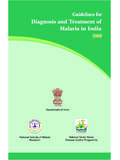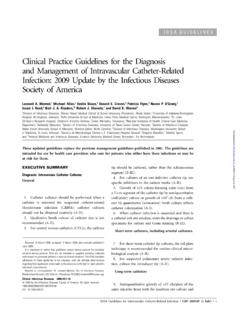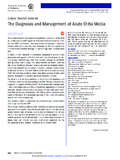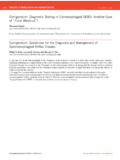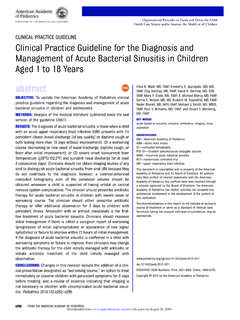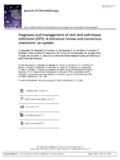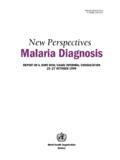Transcription of Diagnosis and Treatment of Malaria in India
1 Guidelines for Diagnosis and Treatment of Malaria in India 2009 Guidelines for Diagnosis and Treatment of Malaria in India 2009 Government of IndiaNational Vector Borne Disease Control ProgrammeNational Institute of Malaria Research Malaria is a major public health problem in India , accountingfor sizeable morbidity, mortality and economic loss. Apartfrom preventive measures, early Diagnosis and complete treatmentare the important modalities that have been adopted to containthe disease. In view of widespread chloroquine resistance inPlasmodium falciparum infection, and other recent developments,the national policy has been revised to meet these guidelines on Diagnosis and Treatment of Malaria in India (2009) have been developed during the brainstorming meetingorganized by the National Institute of Malaria Research (NIMR)and sponsored by WHO Country Office in India .
2 These guidelinesare the collaborative effort of National Vector Borne DiseaseControl Programme, National Institute of Malaria Research andexperts from different parts of the country. The aim of thisendeavour is to guide the medical professionals on the currentmethods of Diagnosis and Treatment based on the nationaldrug policy (2008). This manual deals with the Treatment ofuncomplicated Malaria and specific antimalarials for severedisease. The general management should be carried out accordingto the clinical condition of the patient and judgement of the treatingphysician. The warning signs of severe Malaria have been listedso as to recognize the condition and give the initial treatmentcorrectly before referring them to a higher is hoped that these guidelines will be useful for doctorsinvolved in the management of , NIMRD irector, features of uncomplicated Malaria Form1 Guidelines for Diagnosis and Treatment of malaria1.
3 IntroductionMalaria is one of the major public health problems of thecountry. Around million confirmed cases are reported annuallyby the National Vector Borne Disease Control Programme(NVBDCP), of which 40 50% are due to Plasmodium is curable if effective Treatment is started early. Delay intreatment may lead to serious consequences including and effective Treatment is also important for controllingthe transmission of the past, chloroquine was effective for treating nearly allcases of Malaria . In recent studies, chloroquine-resistant Malaria has been observed with increasing frequencyacross the country. The continued Treatment of such cases withchloroquine is probably one of the factors responsible for increasedproportion of P. falciparum relative to P. revised National Drug Policy on Malaria has been adoptedby the Ministry of Health and Family Welfare in 2008 and theseguidelines have therefore been prepared for clinicians involved inthe Treatment of Clinical featuresFever is the cardinal symptom of Malaria .
4 It can be intermittentwith or without periodicity or continuous. Many cases have chillsand rigors. The fever is often accompanied by headache, myalgia,arthralgia, anorexia, nausea and vomiting. The symptoms ofmalaria can be non-specific and mimic other diseases like viralinfections, enteric fever should be suspected in patients residing in endemicareas and presenting with above symptoms. It should also besuspected in those patients who have recently visited an endemicarea. Although Malaria is known to mimic the signs and symptomsof many common infectious diseases, the other causes shouldalso be suspected and investigated in the presence of followingmanifestations:2 Guidelines for Diagnosis and Treatment of Malaria Running nose, cough and other signs of respiratoryinfection Diarrhoea/dysentery Burning micturition and/or lower abdominal pain Skin rash/infections Abscess Painful swelling of joints Ear discharge LymphadenopathyAll clinically suspected Malaria cases should be investigatedimmediately by microscopy and/or Rapid Diagnostic Test (RDT).
5 3. MicroscopyMicroscopy of stained thick and thin blood smears remainsthe gold standard for confirmation of Diagnosis of advantages of microscopy are: The sensitivity is high. It is possible to detect malarial parasitesat low densities. It also helps to quantify the parasite load. It is possible to distinguish the various species of malariaparasite and their different Rapid Diagnostic TestRapid Diagnostic Tests are based on the detection ofcirculating parasite antigens. Several types of RDTs are available( ). Some of them can only detectP. falciparum, while others can detect other parasite species latter kits are expensive and temperature sensitive. Presently,NVBDCP supplies RDT kits for detection of P. falciparum atlocations where microscopy results are not obtainable within24 hours of sample for Diagnosis and Treatment of malariaRDTs are produced by different companies, so there may bedifferences in the contents and in the manner in which the test isdone.
6 The user s manual should always be read properly andinstructions followed meticulously. The results should be read atthe specified time. It is the responsibility of the clinician ortechnician doing a rapid test for Malaria to ensure that the kit iswithin its expiry date and has been transported and stored underrecommended conditions. Failure to observe these criteria canlead to false/negative results. It should be noted that Pf HRP2based kits may show positive result up to three weeks of Diagnosis and Treatment of cases of malariaaims at: Complete cure Prevention of progression of uncomplicated Malaria tosevere disease Prevention of deaths Interruption of transmission Minimizing risk of selection and spread of drug Treatment of uncomplicated malariaAll fever cases diagnosed as Malaria by RDT or microscopyshould promptly be given effective Treatment of P.
7 Vivax casesPositive P. vivax cases should be treated with chloroquine infull therapeutic dose of 25 mg/kg divided over three days. Vivaxmalaria relapses due to the presence of hypnozoites in the relapse rate in vivax Malaria in India is around 30%. For itsprevention, primaquine may be given at a dose of mg/kgdaily for 14 days under supervision. Primaquine is contraindicatedin G6PD deficient patients, infants and pregnant women. Cautionshould be exercised before administering primaquine in areas4 Guidelines for Diagnosis and Treatment of malariaknown to have high prevalence of G6PD deficiency, therefore, itshould be tested if facilities are available. Primaquine can lead tohemolysis in G6PD deficiency. Patient should be advised to stopprimaquine immediately if he develops symptoms like darkcoloured urine, yellow conjunctiva, bluish discolouration of lips,abdominal pain, nausea, vomiting etc.
8 And should report to thedoctor Treatment of P. falciparum casesThe Treatment of P. falciparum Malaria is based on areasidentified as chloroquine resistant/ sensitive as listed in Combination Therapy (ACT) should be given inresistant areas whereas chloroquine can be used in sensitiveareas. ACT should be given only to confirmed P. falciparum casesfound positive by microscopy or What is ACT?ACT consists of an artemisinin derivative combined with along acting antimalarial (amodiaquine, lumefantrine, mefloquineor sulfadoxine-pyrimethamine). The ACT used in the nationalprogramme in India is artesunate + sulfadoxine-pyrimethamine(SP). Presently, Artemether + Lumefantrine fixed dose combinationand blister pack of artesunate + mefloquine are also available inthe country. Other ACTs which will be registered and authorizedfor marketing in India may be used as Should artemisinin derivatives be given alone?
9 Artemisinin derivatives must never be administered asmonotherapy for uncomplicated Malaria . These rapidly actingdrugs, if used alone, can lead to development of Treatment in chloroquine-resistant areasAreas which qualify for ACT High Pf endemic districts in seven North-eastern states, AndhraPradesh, Chhattisgarh, Jharkhand, Madhya Pradesh andOrissa (see annexure).5 Guidelines for Diagnosis and Treatment of Malaria Other chloroquine resistant PHCs and clusters of blockssurrounding identified drug resistant foci (see annexure).Individual cases who qualify for ACT Patients with history of travel to listed areas. No clinical or parasitological response to full dose of chloroquinewithin 72 hours of starting the Can ACTs be given in pregnancy?According to current WHO guidelines, ACTs can be given inthe second and third trimester of pregnancy.
10 The recommendedtreatment in the first trimester of pregnancy is Treatment of mixed infectionsMixed infections with P. falciparum should be treated asfalciparum Treatment based on clinical criteria withoutlaboratory confirmationAll efforts should be made to diagnose Malaria either bymicroscopy or RDT. However, special circumstances should beaddressed as mentioned is the Treatment , if RDT is negative and a microscopyresult cannot be obtained within 24 hours?If RDT for only P. falciparum is used, negative cases showingsigns and symptoms of Malaria without any other obvious causefor fever should be considered as clinical Malaria and treatedwith chloroquine in full therapeutic dose of 25 mg/kg body weightover three days. If a slide result is obtained later, the treatmentshould be adjusted according to is the Treatment , if neither RDK nor microscopy isavailable?


